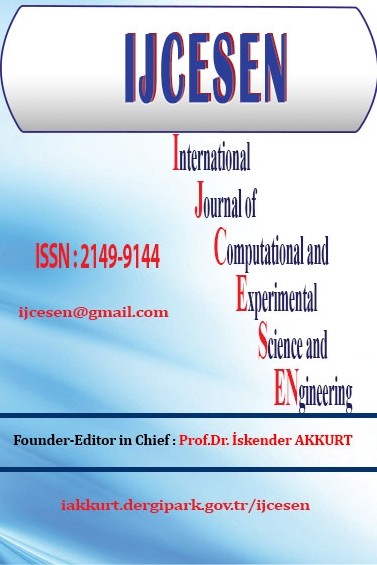Qualitative Research on the Radiation Knowledge Levels of Non-Doctor Healthcare Workers and Developing Qualitative Scale
Qualitative Research on the Radiation Knowledge Levels of Non-Doctor Healthcare Workers and Developing Qualitative Scale
Knowledge level, Ionizing radiation Risk perception,
___
- [1] GÜNAY, O., SARIHAN, M., ABAMOR, E., & YARAR, O. (2019). Environmental radiation doses from patients undergoing Tc-99m DMSA cortical renal scintigraphy. International Journal of Computational and Experimental Science and Engineering, 5(2); 86-93.
- [2] Terekli, G., Özkan, O., & BAYIN, G. (2013). Çevre dostu hastaneler: Hastaneden yeşil hastaneye. Ankara Sağlık Hizmetleri Dergisi, 12(2); 37-54.
- [3] Regulla, D. F., & Eder, H. (2005). Patient exposure in medical X-ray imaging in Europe. Radiation protection dosimetry, 114(1-3); 11-25.
- [4] UZUNTARLA, Y., & DOĞAN, F. (2019). Bir Eğitim ve Araştırma Hastanesinde Dozimetre Taşıyan Sağlık Personelinin İyonlaştırıcı Radyasyon Hakkındaki Risk Algısı ve Bilgi Düzeyinin Belirlenmesi. Sağlık Bilimleri ve Meslekleri Dergisi, 6(1); 34-41.
- [5] Yaren, H., & KARAYILANOĞLU, T. (2005). Radyasyon ve insan sağlığı üzerine etkileri. TSK Koruyucu Hekimlik Bülteni, 4(4); 199-208.
- [6] Hastanesi, E. Ü. T. F. (2014). Radyasyon güvenliği el kitabı.
- [7] Shapiro, J. (2002). Radiation protection: a guide for scientists, regulators, and physicians. La Editorial, UPR.
- [8] Zakariya, N. I., & Kahn, M. T. E. (2014). Benefits and biological effects of ionizing radiation. Sch. Acad. J. Biosci, 2(9); 583-591.
- [9] Russell, J. G. B., & Webb, G. A. M. (1987). Valuing the man-sievert in X-ray diagnosis. The British Journal of Radiology, 60(715); 681-684.
- [10] Burrows, E. H. (1986). Pioneers and early years. A history of British radiology.
- [11] Ron, E. (2003). Cancer risks from medical radiation. Health physics, 85(1); 47-59.
- [12] ÇELİK, H., KOYUNCU, İ., KARAKILÇIK, A. Z., GÖNEL, A., & MUSA, D. (2016). Radyasyonlu Ortamlarda Çalışan İnsanlarda İyonize ve Non-İyonize Radyasyonun Oksidatif Stres ve Antioksidan Seviye Üzerindeki Etkileri. Bezmialem Science, 3; 106-9.
- [13] Schmid, E., & Schrader, T. (2007). Different biological effectiveness of ionising and non-ionising radiations in mammalian cells. Advances in Radio Science, 5; 1-4.
- [14] Sowa, P., Rutkowska-Talipska, J., Sulkowska, U., Rutkowski, K., & Rutkowski, R. (2012). Ionizing and non-ionizing electromagnetic radiation in modern medicine. Polish Annals of Medicine, 19(2), 134-138.
- [15] Bolus, N. E. (2001). Basic review of radiation biology and terminology. Journal of nuclear medicine technology, 29(2); 67-73.
- [16] Koçyiğit, A., Kaya, F., Çetin, T., Kurban, I., Erbaş, T., Ergin, A., ... & Karabulut, N. (2014). Radyolojik tetkikler sırasında maruz kalınan radyasyon hakkında sağlık personelinin bilgi düzeyleri. Pamukkale Tıp Dergisi, 7(2);137-142.
- [17] Frischknecht, R., Braunschweig, A., Hofstetter, P., & Suter, P. (2000). Human health damages due to ionising radiation in life cycle impact assessment. Environmental impact assessment Review, 20(2); 159-189.
- [18] Garcia-Sanchez, A. J., Garcia Angosto, E. A., Moreno Riquelme, P. A., Serna Berna, A., & Ramos-Amores, D. (2018). Ionizing radiation measurement solution in a hospital environment. Sensors, 18(2); 510.
- [19] Çokluk, E., Çokluk, S., Şekeroğlu, R., & Huyut, Z. (2016). Sağlık hizmetleri sektöründe risk algısı: Hastane Laboratuvar ön çalışması. Türk Klinik Biyokimya Dergisi, 14(2); 125-130.
- [20] MANAVGAT, S. S., & MANDIRACIOĞLU, A. (2012). ege üniversitesi tıp fakültesi hastanesi’nde kişisel dozimetre taşıyan çalışanların mesleksel iyonlaştırıcı radyasyon risk algısı. TTB Mesleki Sağlık ve Güvenlik Dergisi, 12(43); 34-43.
- [21] Creswell, J. W. (2013). Nitel araştırma yöntemleri: Beş yaklaşıma göre nitel araştırma ve araştırma deseni (3. Baskıdan Çeviri). M. Bütün ve SB Demir, Çev.). Ankara: Siyasal Kitabevi.
- [22] Neuman, W. (2007). Sosyal Araştırma Yöntemlerinin Temelleri: Nitel ve Nicel Yaklaşımlar. Boston: Allyn ve Bacon.
- [23] International Commission on Radiological Protection. (2007). Radiological protection in medicine. ICRP Publication 105. Ann. ICRP, 37(6); 1-64.
- Yayın Aralığı: 4
- Başlangıç: 2015
- Yayıncı: Prof.Dr. İskender Akkurt
Zeynep Büşra BALIK, Gülşen AKOĞLU
Personalized Intraoperative Radiotherapy Balloon Applicator Design and Production With 3D Printer
Öykü YÜZER, Betül ÖZER, Salih Enes ÖZDEL, Osman GÜNAY
Emission and Lubrication Performance of Hazelnut Oil as A Lubricant
Method Validation and Measurement Uncertainty for the Determination of Ethanol in Whole Blood
Radiation Safety For Operating Room Technicians
Shear Behaviour of RC Beams: A Numerical Study
Şeyma ÖZSOY, Elif Azize ÖZŞAHİN DELİBAŞ, Gürkan YİĞİTTÜRK
The Effect of Fragment C of Tetanus Toxin on Memory Deficits in a Rat Model of Alzheimer’s Disease
